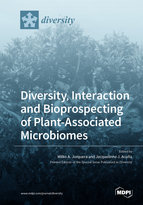Diversity, Interaction and Bioprospecting of Plant-Associated Microbiomes
A special issue of Diversity (ISSN 1424-2818). This special issue belongs to the section "Microbial Diversity and Culture Collections".
Deadline for manuscript submissions: closed (31 October 2021) | Viewed by 40749
Special Issue Editors
Interests: airborne microbiomes; algae-associated microbiomes; bacterial community diversity; extremophilic bacteria; plant-associated microbiomes; plant growth-promoting bacteria; sediment-associated microbiomes; soil microbiology
Special Issues, Collections and Topics in MDPI journals
Special Issue Information
Dear Colleagues,
Numerous studies in the last few decades have demonstrated that microbiomes are pivotal for the growth and fitness of plants in diverse ecosystems. These studies have revealed that plants are able to recruit a varied and specific microbial community according to their genotype, phenological stages, and plant niches. In this sense, diverse niches have been identified in plants, such as rhizosphere, endosphere, phyllosphere, spermosphere, and plant detritusphere, where the local conditions influence the colonization, proliferation, and plant–microbe interactions.
In addition, studies have also revealed that plant-associated microbiomes not only harbor a wide diversity of specific microbial communities but also can harbor beneficial microbes, commonly termed plant growth-promoting microorganisms (PGPMs), which have been extensively studied, bioprospected, and applied as commercial microbial inoculants. Thus, PGPMs have been used by farmers as biofertilizers to improve plant nutrition and as biocontrol agents to prevent the attack of phytopathogens. In this context, prolonged drought periods and sudden heavy rains and cold/hot waves have affected diverse agricultural regions worldwide as result of climate change. This world challenge has also motivated the search and the potential use of PGPMs as agents to mitigate the effect of abiotic stress (e.g., increased soil salinity, water shortages, flooding, etc.) on crops, orchards, and pastures in arid and semiarid agricultural areas.
On the other hand, the use of culture-independent approaches and next-generation omics technologies have opened a new window for the study of plant-associated microbiomes, revealing the wide diversity of microorganisms in plant niches as never before seen. However, the functions and interconnectivity of microbe–microbe and microbe–plant interactions is still considered a black box, where traditionally culture-based approaches are used toward the isolation and characterization of selected beneficial microbes and bioprospecting for their potential biotechnological applications in agriculture and degraded soil recovery under a changing world.
For this Special Issue, we invite microbiologists, biologists, agriculturists, biochemists, and biotechnologists to contribute to a new understanding of microbial diversity, ecological interactions, and bioprospecting of microbiomes associated with plants living in a wide variety of ecosystems, including agricultural systems, pristine or undisturbed environments, extreme environments, etc.
Contributions can be focused on (but are not limited to):
- Microbial diversity and coevolution in plant niches (rhizosphere soil, endosphere, phyllosphere, spermosphere, and detritusphere or plant litters);
- Role and influence of plant-associated microbiomes on growth, nutrition, and tolerance of plants;
- Effect of soil management, fertilization, and/or abiotic stress on microbial diversity and functioning of plant-associated microbiomes;
- Plant-associated microbiomes’ response to climate change;
- Use of molecular and culture-based approaches in the monitoring and/or tracking of specific microbes in plant-associated microbiomes;
- Bioprospecting of novel plant growth-promoting microorganisms (and/or their biomolecules) isolated from plant-associated microbiomes.
Interdisciplinary approaches to investigate microbial-mediated processes in plant niches are welcome, such as next-generation multi-omics, microbial ecology, conservation and management of soils, and microbial bioprospecting for the sustainable development and study of plant–microbe interactions, among others.
Dr. Milko A. Jorquera
Dr. Jacquelinne Acuña
Guest Editors
Manuscript Submission Information
Manuscripts should be submitted online at www.mdpi.com by registering and logging in to this website. Once you are registered, click here to go to the submission form. Manuscripts can be submitted until the deadline. All submissions that pass pre-check are peer-reviewed. Accepted papers will be published continuously in the journal (as soon as accepted) and will be listed together on the special issue website. Research articles, review articles as well as short communications are invited. For planned papers, a title and short abstract (about 100 words) can be sent to the Editorial Office for announcement on this website.
Submitted manuscripts should not have been published previously, nor be under consideration for publication elsewhere (except conference proceedings papers). All manuscripts are thoroughly refereed through a single-blind peer-review process. A guide for authors and other relevant information for submission of manuscripts is available on the Instructions for Authors page. Diversity is an international peer-reviewed open access monthly journal published by MDPI.
Please visit the Instructions for Authors page before submitting a manuscript. The Article Processing Charge (APC) for publication in this open access journal is 2600 CHF (Swiss Francs). Submitted papers should be well formatted and use good English. Authors may use MDPI's English editing service prior to publication or during author revisions.







